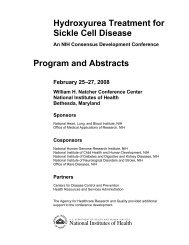pubertal delay, iron deficiency, dental enamel defects, and abnormalities in liver function test).Atypical presentation is usually encountered in association with the late onset of complaints,particularly in older children. Dermatitis herpetiformis, a blistering skin disease, is presentlyregarded as a variant of CD.CD is defined as silent whenever a typical gluten-sensitive enteropathy is found in asubject who is apparently healthy. Large numbers of silent cases of CD have been reported in atriskgroups (such as subjects with insulin-dependent diabetes and first-degree relatives) and ingeneral population samples enrolled in screening programs. An indepth clinical examinationshows that many of these “silent” cases are indeed affected with a low-grade intensity illnessoften associated with decreased psychophysical well-being.Finally, a potential form of CD is diagnosed in subjects showing positivity of EMAand/or anti-tTG antibodies, the typical HLA predisposing genotype (DQ2 or DQ8), but a normalor minimally abnormal mucosal architecture (increased IEL count) at the intestinal biopsy. Thesecases are at risk of developing a typical CD enteropathy later in life.Untreated CD is associated with a list of diseases and complications (1) (table 2). Thepossible association with Down syndrome is well known. Two recent studies provided furtherevidence of an increased prevalence of CD in Down syndrome in the United States, with areported frequency of this disease association of 3.2–10.3 percent, respectively. (8,9) In Downsyndrome children, CD is not detectable on the basis of clinical findings alone and is thereforeunderdetected. Even when there are symptoms, they may be considered clinically insignificant orpossibly attributed to Down syndrome itself. Nevertheless, the reported resolution orimprovement of gastrointestinal complaints on a GFD for all symptomatic patients suggest thatidentification and treatment can improve the quality of life for these children.Table 2. Associated <strong>Disease</strong>sAssociated <strong>Disease</strong>sDown syndromeTurner syndromeWilliams syndromeIgA deficiencyAssociated <strong>Disease</strong>s Possibly Secondary to Untreated CDAutoimmune diseases (e.g., type 1 diabetes, thyroiditis, hepatitis,primary biliary chirrosis)Epilepsy with or without occipital calcificationsAtaxia and other neurological disturbancesIgA nephropathyAn increasing number of studies show that many CD-associated problems that wereoriginally described mostly in adults can indeed be observed in children or adolescents. (7)Osteoporosis is one of the well-known complications of untreated CD in adults. Several studiesshowed that bone mineral content, bone area, and bone mineral density could be significantlylower in CD adolescents than in controls. Further, it has been reported that a complete recoveryof bone density can occur after 1 year of GFD, and maintenance of normal bone mineral densityis achieved after long-term treatment. In the last decade, there has been an explosion of intereston the neurological manifestations associated with CD. The existence of a syndromecharacterized by epilepsy, occipital calcifications, and CD is generally accepted. The strongassociation with autoimmune diseases, including type 1 diabetes (10,11) and thyroid disease (11) has62
een widely reported. The question regarding the possible role of an early treatment of CD onthe development of autoimmune complications is still open for debate. While some studiessuggest that children with untreated CD have higher than expected prevalence of organ-specificautoantibodies (apparently “gluten-dependent”), which tend to disappear after starting the GFD,others deny this cause-effect relationship. (7)ConclusionsCD is a common disorder in children as well as in adults. The spectrum of clinicalpresentations is wide, and currently extra-intestinal manifestations (e.g., anemia or short stature)are more common than the classical malabsorption symptoms. A high degree of awarenessamong health care professionals and a “liberal” use of serological CD tests can help to identifymany of the atypical cases. The primary care physician has a central role in this process of casefinding.References1. Fasano A, Catassi C. Current approaches to diagnosis and treatment of celiac disease: anevolving spectrum. Gastroenterology. 2001;120:636–651.2. Catassi C, Fabiani E, Ratsch IM, et al. The coeliac iceberg in Italy. A multicentre antigliadinantibodies screening for coeliac disease in school-age subjects. Acta Paediatr Suppl.1996;412:29–35.3. Hill I, Fasano A, Schwartz R, Counts D, Glock M, Horvath K. The prevalence of celiacdisease in at-risk groups of children in United States. Ped Res. 2000;136:86–90.4. Hoffenberg EJ, MacKenzie T, Barriga KJ, et al. A prospective study of the incidence ofchildhood celiac disease. J Pediatr. 2003;143:308–314.5. Fasano A, Berti I, Gerarduzzi T, et al. A multicenter study on the sero-prevalence of celiacdisease in the United States among both at-risk and not-at-risk groups. Arch Int Med.2003;163:286–292.6. Maki M, Mustalahati K, Kokkonen J, et al. Prevalence of celiac disease among children inFinland. N Engl J Med. 2003;348:2517–2524.7. Catassi C, Fasano A. New developments in childhood celiac disease. Curr GastroenterolRep. 2002;4:238–243.8. Mackey J, Treem WR, Worley G, Boney A, Hart P, Kishnani PS. Frequency of celiac diseasein individuals with Down syndrome in the United States. Clin Pediatr. 2001;40:249–252.9. Book L, Hart A, Black J, Feolo M, Zone JJ, Neuhausen SL. Prevalence and clinicalcharacteristics of celiac disease in Down syndrome in a U.S. study. Am J Med Gen.2001;98:70–74.63
- Page 1 and 2:
NIH Consensus Development Conferenc
- Page 3 and 4: III. What Are the Manifestations an
- Page 5 and 6: • What is the management of celia
- Page 7 and 8: Monday, June 28, 2004 (continued)I.
- Page 9 and 10: Monday, June 28, 2004 (continued)II
- Page 11 and 12: Wednesday, June 30, 2004 (continued
- Page 13 and 14: Lisa H. RichardsonConsumer Represen
- Page 15 and 16: Ciaran P. Kelly, M.D.Director, Celi
- Page 17 and 18: Van S. Hubbard, M.D., Ph.D.Director
- Page 19 and 20: AbstractsThe following are abstract
- Page 21 and 22: susceptibility (e.g., DR17 homozygo
- Page 23 and 24: The Pathology of Celiac DiseaseDavi
- Page 25 and 26: In this regard, the transport pathw
- Page 27 and 28: for the IgG-based test, while speci
- Page 29 and 30: 15. de Lecea A, Ribes-Koninckx C, P
- Page 31 and 32: Clinical Algorithm in Celiac Diseas
- Page 33 and 34: Considera diagnosisof celiac diseas
- Page 35 and 36: There are populations at particular
- Page 37 and 38: Serological Testing for Celiac Dise
- Page 39 and 40: Estimates of the sensitivity of the
- Page 41 and 42: the risk and severity of CD may als
- Page 43 and 44: What Are the Prevalence and Inciden
- Page 45 and 46: ascribed to excess menstrual loss.
- Page 47 and 48: ReferencesFamily History of Celiac
- Page 49 and 50: Carroccio A, Iannitto E, Cavataio F
- Page 51 and 52: identified by surveys or through so
- Page 53: Clinical Presentation of Celiac Dis
- Page 57 and 58: The Many Faces of Celiac Disease: C
- Page 59 and 60: References1. Green PH, Jabri B. Coe
- Page 61 and 62: Association of Celiac Disease and G
- Page 63 and 64: Does the Gluten-Free Diet Protect F
- Page 65 and 66: Skin Manifestations of Celiac Disea
- Page 67 and 68: allow a better understanding of the
- Page 69 and 70: 4. Henriksson KG, Hallert C, Walan
- Page 71 and 72: characterized, clinically-identifie
- Page 73 and 74: 10. Hoffenberg EJ, Emery LM, Barrig
- Page 75 and 76: ataxia, epilepsy with posterior cer
- Page 77 and 78: Consequences of Testing for Celiac
- Page 79 and 80: Osteoporosis/FracturesThere were 11
- Page 81 and 82: Dietary Guidelines for Celiac Disea
- Page 85 and 86: 21. Thompson T. Thiamin, riboflavin
- Page 88 and 89: In order to effectively counsel ind
- Page 90 and 91: 9. Hallert C, Granno C, Hulten S, M
- Page 92 and 93: adhered to the GFD after more than
- Page 94 and 95: Patient education, close supervisio
- Page 96: 26. Mustalahti K, Lohiniemi S, Laip







